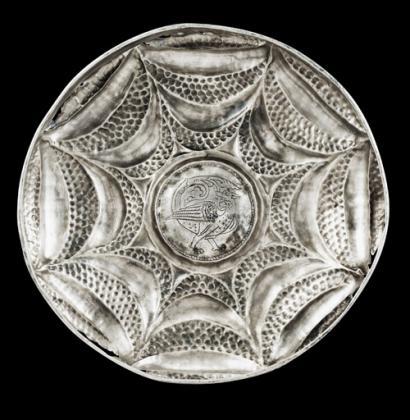
Late 12th Century French Silver Cup From the Time of the Knights of the Round Table |
|
DATE OF SALE
Session 1: Tue, 17 May, 11:00 AM
Session 2: Tue, 17 May, 2:30 PM
VIEWING:
Fri, 13 May, 10:00 AM-6:00 PM
Sat, 14 May, 10:00 AM-6:00 PM
Mon, 16 May, 10:00 AM-6:00 PM
SOTHEBY'S
76 rue du Faubourg Saint-Honoré
75008 Paris
Tel: +33 (0)1 53 05 53 05
Fax: +33 (0)1 47 42 22 32
SPECIALISTS
Thierry de Lachaise
Tel: +33 (0)1 53 05 53 21
thierry.de.lachaise@sothebys.com
Julia Clarke
Tel: +44 20 7293 5324
julia.clarke@sothebys.com
PRESS CONTACT:
Sophie Dufresne
Tel: 33 (0)1 53 05 53 66
sophie.dufresne@sothebys.com

|
Sotheby's sale of Important European Silver, Gold Boxes & Objects Vertu in Paris on May 17 will include an exceptional silver drinking cup made around 1180, probably in France (estimate €300,000–400,000*). No public or private collection holds a piece of such age and with this specific iconography.
The cup's decoration is spangled with astral symbols. The eight-branch star, the two circles around the basilisk, and the moon-like shapes evoke scientific works of the early medieval period, and portrayals of the heavens by Western and Oriental astrologists. The planet-like seeds can be interpreted as pomegranate seeds symbolizing fertility. The geometric design, and the creature engraved in the centre of the goblet, are typical of the early Middle Ages. The Basilisk features prominently in 12 th/13th century imagery, but is rarer later. This dragonlike creature, known as the king of serpents and embodiment of evil, could petrify a man with its mere glance.
This motif indicates the use to which such cups (or hanaps) were put – most probably for drinking. The basilisk's presence at the bottom of the cup was designed to warn the drinker to act with restraint, i.e. not to drain the vessel to the end and so uncover the monster's image
The cup's ornament leads to the heart of medieval thinking, both moralistic and mythic, embodied in the Book of Proverbs attributed to King Solomon – who was viewed in the Middle Ages as part-exorcist and part-magician, and thereby equal to the monster's threat. It was also around this time that the legend of King Arthur the Knights of the Round Table was written down... with the Round Table destined to receive The Holy Grail, a term designating a cup with a base and stem, like a goblet or chalice (possibly with cover), that first appeared around 1000 A.D.
The pieces in this sale come from all over Europe and include wine-coolers, flatware sets and centre tables. From France comes a pair of two-light candelabra made in 1764 by Jean-Baptiste Chéret and a fine pair of silver-gilt salvers made by Robert-Joseph Auguste for the Portuguese Court in 1784. From Germany come a set of four candlesticks and a pair of ewers from the famous Sachsen-Teschen service, made by Johann Ignaz Würth in Vienna circa 1780, as well as a set comprising a pair of circular wine-coolers and a verriere made in Augsburg in 1804 for a German prince.
Browse online catalogue: www.sothebys.com
|









